|
|
Post by cfmrc on Nov 6, 2023 8:21:39 GMT
Would anyone know what sort of name boards York Road would have been fitted with? I’m assuming solid red circle, blue bar and white lettering. 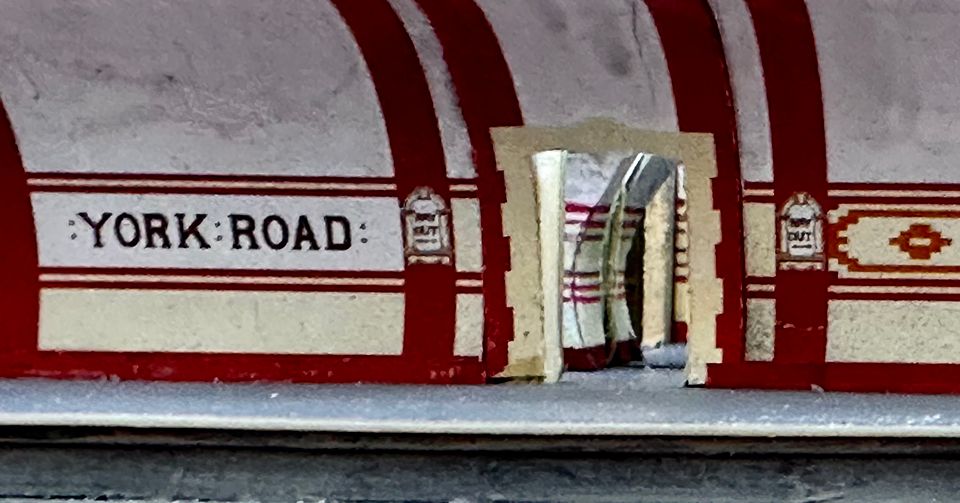 Thanks for any info. Tim |
|
|
|
Post by burkitt on Nov 6, 2023 11:06:21 GMT
I think that's fair to assume Tim, given there seems to be a lack of any photos of the station platforms while open. The photographic evidence from other stations appears to be that while the Johnston-designed "doughnut" roundels were in common use on station platforms from the mid 1920s, this looks to have been entirely at new or refurbished stations. Many stations retained the 1908-onwards solid discs through to at least the 1940s, so York Road is most likely to have kept them until closure. The next question is what type of disc roundels? There were several types to choose from...  This photo of King's Cross Piccadilly platform circa 1910 shows two styles which I know were also both used at Brompton Road, so appear to have been common on the line, so likely to be found at York Road. The rear disc, positioned lower on the wall, was a metal circle attached over the tiling, and a wood-framed metal bar with the station name. In the foreground is a rarer type, where the lower half of the circle was metal, but the upper half was painted on the tiling and plaster - remnants of one of these exist at Brompton Road.  The painting of the upper half of the disc over the plaster and tiling is more apparent in this 1923 photo of the Hampstead tube (now Northern line) platform at Strand (now Charing Cross). Note how the lower half obscures the Leslie Green "way out" cartouche, necessitating the enamelled replacement below. Also, the high-level discs at both Strand and King's Cross have been aligned with the tiling bands that wrap over the tunnel ceiling. Edit - it occurs to me that both high-level discs have been paired with "way out" signs below them. Perhaps the high level discs were only used when a "way out" sign was also needed in the same location? (even if that meant obscuring the Leslie Green cartouche)  There were also disc roundels on square metal backgrounds, as here at Charing Cross (now Embankment) on the Hampstead tube in 1923. These were introduced from 1913 and used on newly built tube platforms, as at Charing Cross where the Hampstead platform opened in 1914. Thus I think this design is less likely to have been found at York Road. |
|
|
|
Post by cfmrc on Nov 6, 2023 12:10:46 GMT
Many thanks for that information. There is a photo of the York Road platform in use: 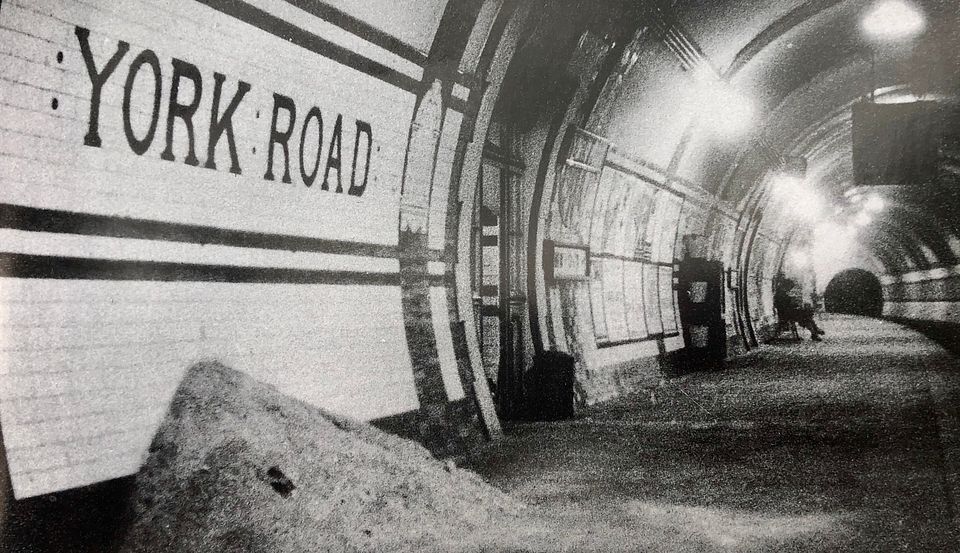 (Courtesy Jim Connor) I wonder what the pile in the foreground was? Tim |
|
|
|
Post by burkitt on Nov 6, 2023 12:57:18 GMT
That's an excellent photo Tim, not one I'd remembered seeing, though of course it's in "London's Disused Underground Stations" which was on the shelf behind me!
There's definitely a high-level disc roundel with "way out" sign below just right of the side passage in the foreground. Looks like there may be another disc roundel above a sign further back as well - just to the right of the cabinet with the bucket on top.
I'd guess the pile is sand - maybe for the fire buckets? Odd to just pile it on the platform like that though.
|
|
DWS
every second count's
Posts: 2,487
|
Post by DWS on Nov 6, 2023 13:33:58 GMT
The pile of sand may be for permanent way staff if the track in the platform was being refurbished. Sand for fire buckets was usual stored in a red metal bin placed near the head wall.
|
|
|
|
Post by d7666 on Nov 6, 2023 16:44:09 GMT
Or perhaps the pile of (what looks like but might not be ) sand should not have been there which might just be why the photo was taken with it being so prominent ?
I'd almost go as far as to say that is a deliberate photo of a pile of sand on a York Road platform, not a photo of York Road that happens to have a pile of sand on a platform.
|
|
|
|
Post by cfmrc on Nov 7, 2023 9:15:08 GMT
Turning attention to the track, I have a solution for making the tube tracks by using lightly milled PCB strips to make the virtually flush, finely ballasted tracks.  The conductor rails will be strips, and from looking at photos it appears that the supports are every three sleepers in the station areas (i.e. one plain sleeper between supports). Would this have been the type in use in the 1920-30s? It would be a lot less work if they were more spaced out! Does anyone know the length of the conductor rails in this type of track? Thanks for your help. Tim |
|
|
|
Post by spsmiler on Nov 7, 2023 11:10:42 GMT
I am using Plastruct / Evergreen 1mm square strip to represent tube tunnel conductor rails. This square format is the closest I've seen to to the real thing. Its white, so will need painting, perhaps dirty black or very dark grey with a dash of black and maybe even brown too. I am yet to experiment with the paint. For your era you will not need the suicide pit. My photo shows a trial run, I've made the support pier a little too low and the conductor rail is just 1 inch long!  edit to add, 11 days later: my photo was on Facebook but appears to have been deleted ... so apologies is no longer visible here |
|
|
|
Post by cfmrc on Nov 7, 2023 11:25:53 GMT
In our exhibition layout environment the rails need to be robust. They will be made of .030 x .020” nickel silver strip soldered to pins.
Tim
|
|
|
|
Post by burkitt on Nov 7, 2023 21:33:59 GMT
...from looking at photos it appears that the supports are every three sleepers in the station areas (i.e. one plain sleeper between supports). Would this have been the type in use in the 1920-30s? It would be a lot less work if they were more spaced out! Does anyone know the length of the conductor rails in this type of track? Thanks for your help. Tim Having looked through the high resolution photos in the LTM archive, I think I can confirm that the blocky insulator design in your diagram was still standard through the 1920s, with the now-conventional circular style introduced later. It does appear to be consistently used on alternating sleepers, so no respite there. |
|
|
|
Post by cfmrc on Nov 8, 2023 11:53:38 GMT
Thanks. That’s 150 x 0.5mm holes through the paxolin sleepers in the station for starters.
Tim
|
|
|
|
Post by cfmrc on Nov 11, 2023 8:44:28 GMT
There has been some progress on getting the platform board mounted under the station. 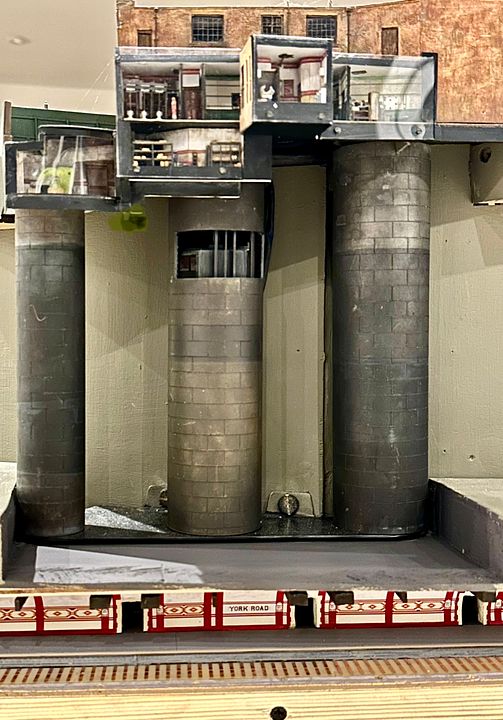 A platform view 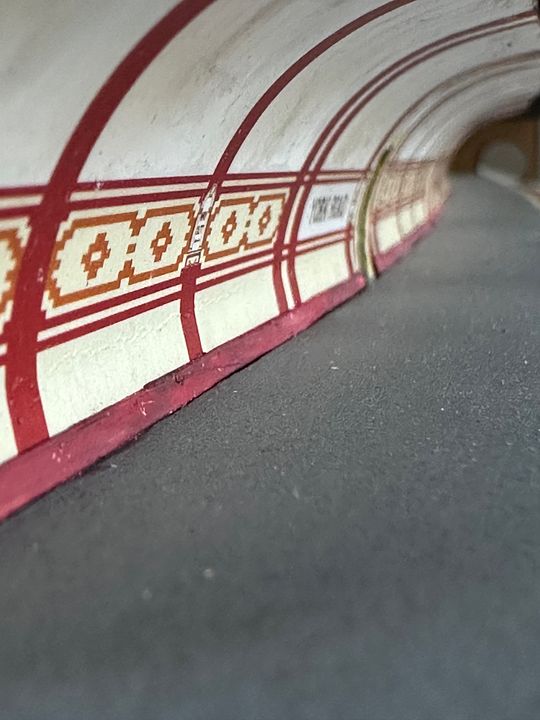 Work continues… Tim |
|
|
|
Post by burkitt on Nov 12, 2023 15:37:18 GMT
It's an incredible model Tim. I've recently discovered this photo of Aldwych station in use as an air raid shelter during WW2, which shows the solid red disc station name very nicely on the right. It's in the higher position, and a "Way Out" sign can be seen beneath it partly hidden under hats and coats.   This shows that the high-level solid discs as seen in the photo of York Road were definitely still in use through to the 1940s (at least on lesser-used stations) so this is very much the appropriate style for York Road in the era you are modelling. |
|
|
|
Post by cfmrc on Nov 13, 2023 0:25:30 GMT
The head lining and top fascia have now been completed and are nice and solid.  I have some 2mm Lighthouse LEDs which should serve as light sources. Not sure if shades will be necessary, but that is the next job. Tim |
|
|
|
Post by burkitt on Nov 13, 2023 11:15:57 GMT
The standard Underground Group lamp shade can just about be seen in the photo you shared of York Road, and made out more distinctly in the photo I posted of Kings Cross. It was hexagonal in shape, made from white opaline glass in a metal frame.  There's one in the London Transport Museum collection, with a photo and dimensions - link
Photos from several angles of what may be a slightly larger outdoor variant can be found on this antiques sales site - link (unfortunately sold out!) |
|
|
|
Post by spsmiler on Nov 13, 2023 14:04:54 GMT
|
|
jimbo
Posts: 1,913
Member is Online
|
Post by jimbo on Nov 13, 2023 19:38:46 GMT
Whitechapel is a post-war version after serious bomb damage. link I looked into this previously: link |
|
|
|
Post by cfmrc on Nov 14, 2023 8:31:37 GMT
Thanks for all the info. The shades are broadly what I used on the main station building: not easily seen with the lights on. 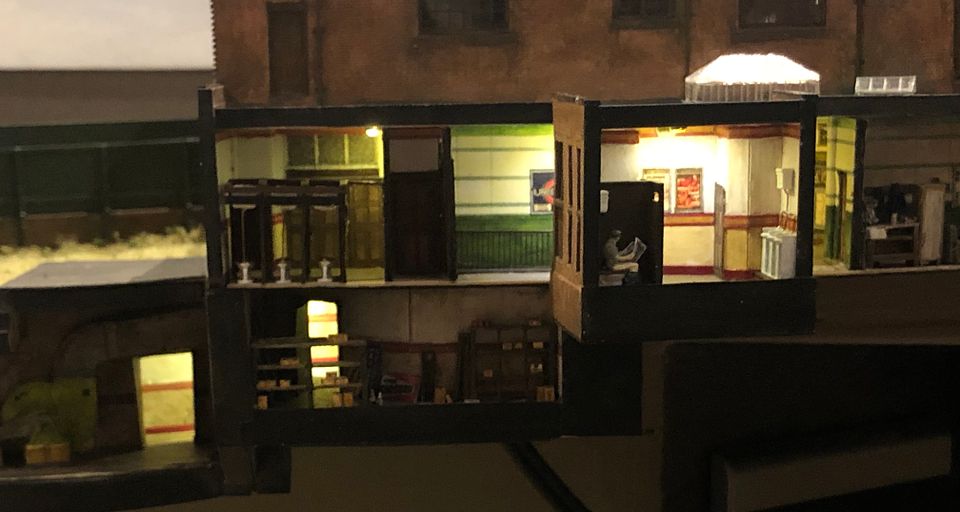 My experiment with the lighthouse LED is looking promising & robust. Thinking of signage, I will need some WAY OUT signs. Presumably same font (but black on white) with a red surround. Tim |
|
|
|
Post by burkitt on Nov 14, 2023 23:18:27 GMT
I'd agree regarding the design of the Way Out sign. The photos of King's Cross and Strand show the Way Out sign using the same typeface as the nameboard, though with letters more widely spaced. The pointing finger should be aligned with the text. Its design can be seen in more detail on this sign originally from Tufnell Park and now in the LTM collection.  Comparison of the shades of grey on the Way Out frame, versus the disc of the nameboard, does indicate the frame should be red, as confirmed by the Tufnell Park sign. |
|
|
|
Post by cfmrc on Nov 16, 2023 18:53:44 GMT
The LEDs have been installed and will need a bit more tweaking - lamp shades etc. 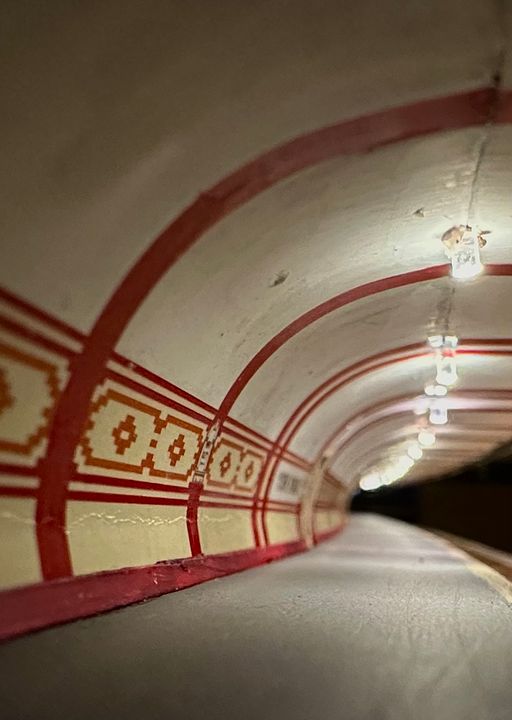
With the body and base of the LEDs blacked out above the ceiling, the lighting can be better controlled. 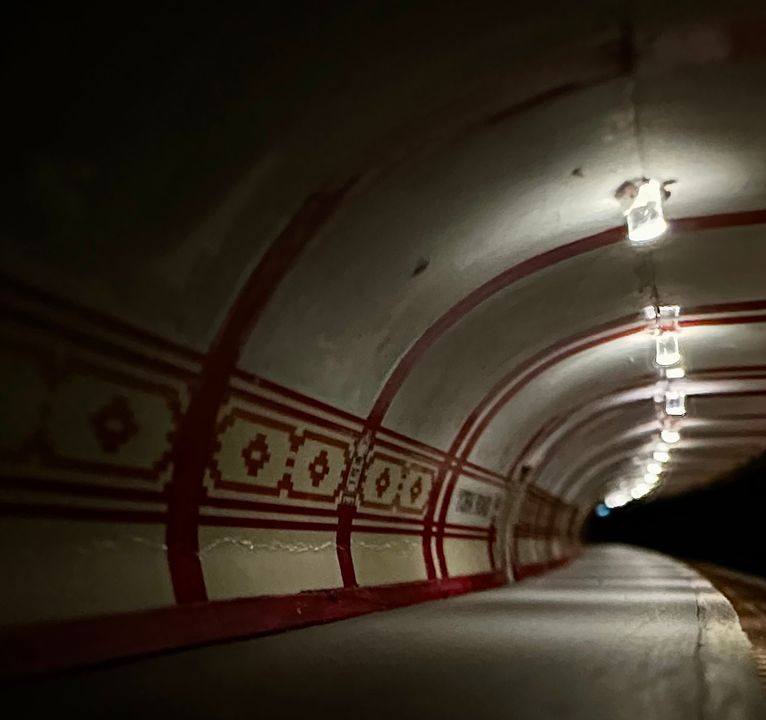 Making a 2D representation of the lamp shades is fairly straightforward, but it might be nice to have the correct shape. Maybe they could be 3D printed in clear resin with a 2mm hole for the LED. I’m also not sure whether or not to leave off the head wall at the western end. It would allow people to get this view. Any thoughts? Tim |
|
brigham
Posts: 2,533  Member is Online
Member is Online
|
Post by brigham on Nov 17, 2023 8:42:38 GMT
You could make the headwall removable. It would be a shame not to be able to photograph that atmospheric view.
|
|
|
|
Post by cfmrc on Nov 17, 2023 10:54:17 GMT
Fear not! It is being designed as open with Perspex end or a head wall in place, but again with Perspex to block the tunnel. There is a view along the track tunnel opening, but it’s not quite the same, obviously.
On the main layout, this view is quite hard to get, so the lamps themselves are quite hard to see. I think a fair number of our audience, having got down to that position, might struggle to get up again! In separate diorama form, it is displayed much higher.
Tim
|
|
|
|
Post by cfmrc on Nov 28, 2023 13:29:16 GMT
YR had its first outing with the main layout at the Warley show last weekend. 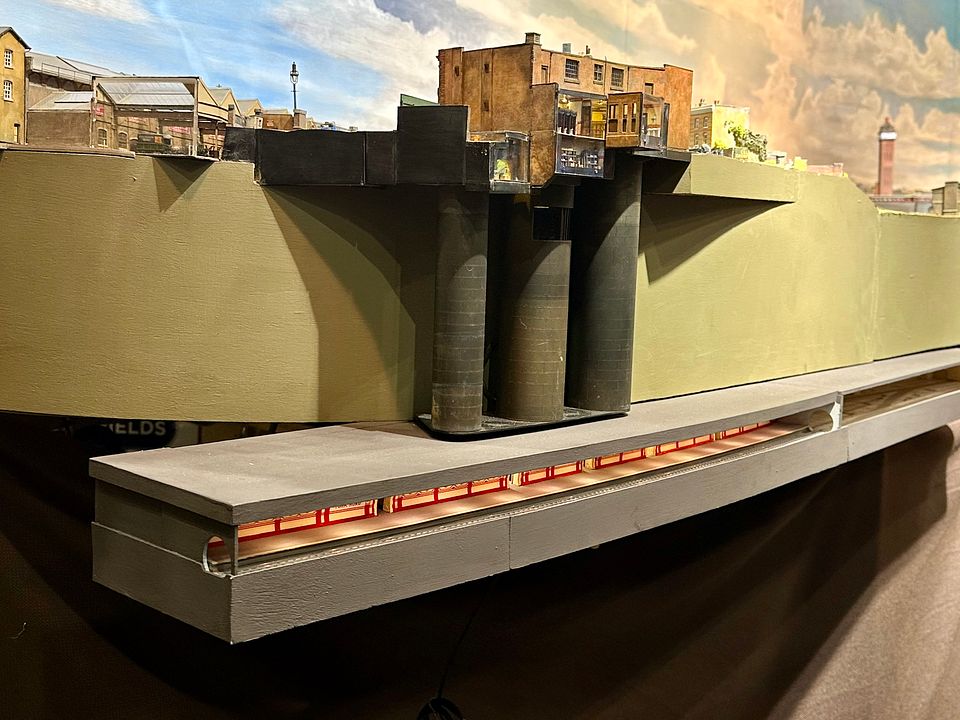 The working lift caught people’s attention and, interestingly, the lights needed turning up a bit to show up more in association with the layout lights. 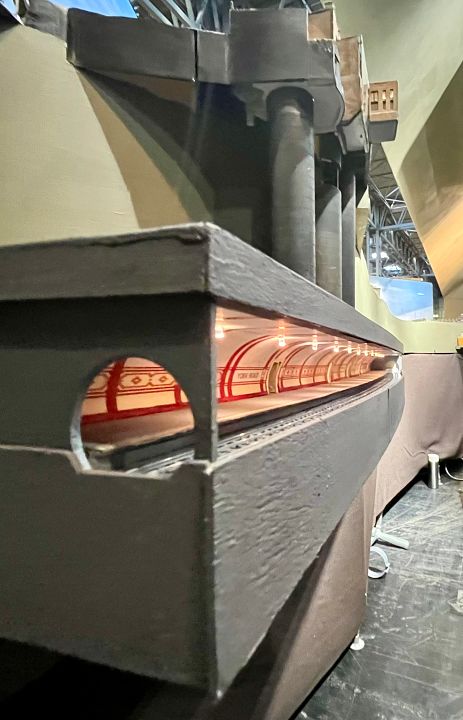 I am minded to cut back the front fascia of the station a little, as the view down into the platforms is slightly impeded. However, this is contrary to the arrangement when the YR tube is displayed in diorama form at a much higher viewing level. Another aspect to model is the spiral staircase in the smaller, third shaft. Does anyone know what colour the ventilation pipe down the middle would have been in the 20s? At the Cally the pipe is a light mid-chrome green. 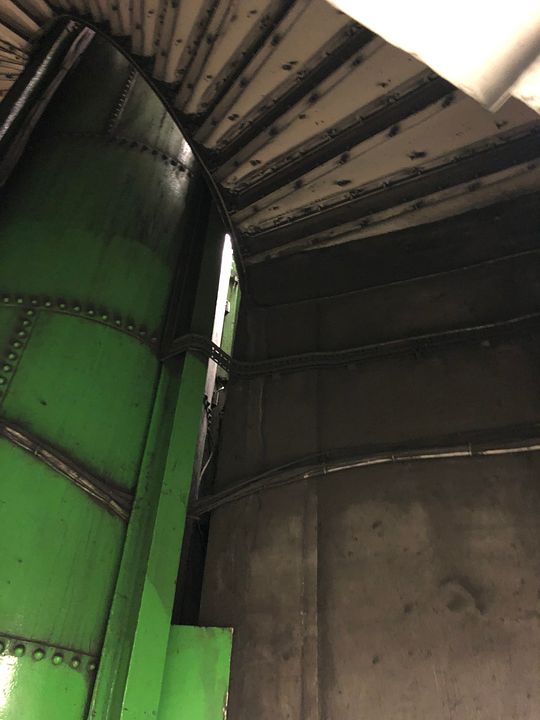 The YR diorama will be on display at the MRC Mini-Exhibition at Keen House (N1 9DA) on 10th December. Tim |
|
DWS
every second count's
Posts: 2,487
|
Post by DWS on Nov 28, 2023 16:31:32 GMT
Not wishing to stop the wonderful work cfmrc is doing this thread would be better off in the Modelling section .
|
|
|
|
Post by cfmrc on Nov 28, 2023 16:42:54 GMT
I can obviously post in that area, but most of my queries relate to prototype info rather than discussion of generally commercial models.
Tim
|
|
Chris M
Global Moderator
Forum Quizmaster
Always happy to receive quiz ideas and pictures by email or PM
Posts: 19,758
|
Post by Chris M on Nov 28, 2023 19:06:12 GMT
Not wish to stop the wonderful work cfmrc is doing this thread would be better off in the Modelling section . Yes, I was thinking that last time this was active. Now moved.
I can obviously post in that area, but most of my queries relate to prototype info rather than discussion of generally commercial models. Tim The initial query was appropriate to either board (or the historical area), but the modelling area is the best place for all types of modelling. |
|
|
|
Post by cfmrc on Dec 1, 2023 22:42:44 GMT
Following on from various discussions on the visibility of the YR tube platform, I decided to adjust both the diorama box and the platform roof itself, cutting back about 1/2” from the top of the latter. This was achieved with a well known fine scale modelling instrument. 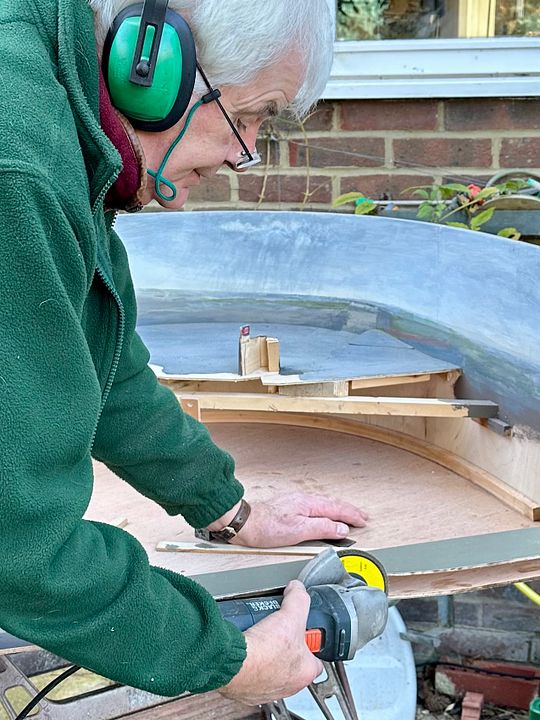 The station track work is now much more visible and is complimented by some pleasant curves in the infrastructure. 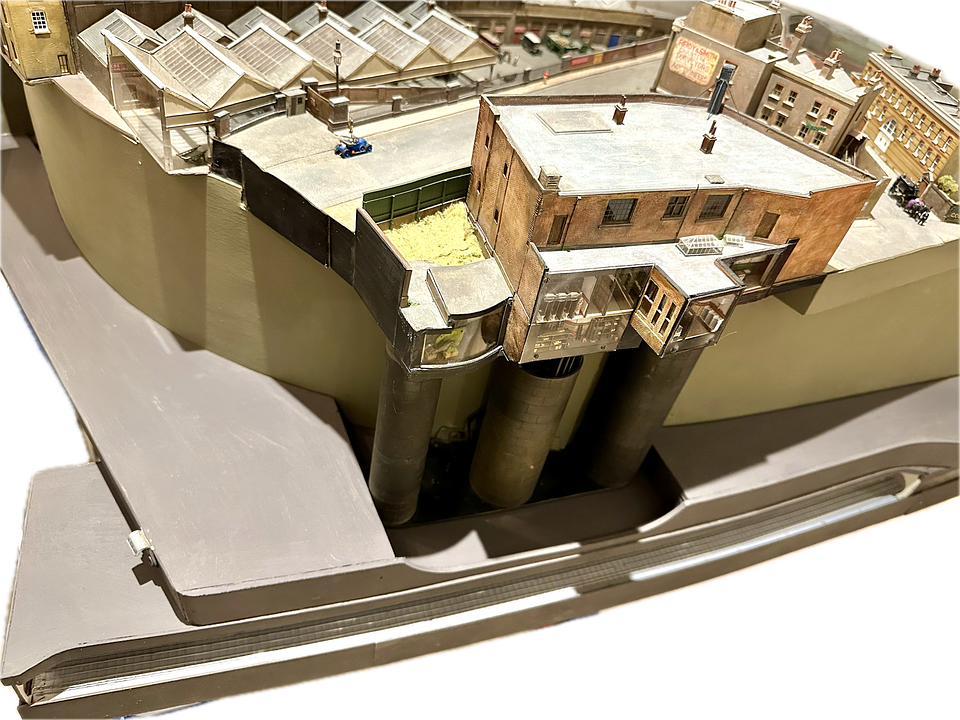 Next job will be to lay some temporary strip track so that we can get a train running for the MRC mini exhibition on 10th December at Keen House. Tim |
|
DWS
every second count's
Posts: 2,487
|
Post by DWS on Dec 2, 2023 4:49:27 GMT
Tim will the MRC mini exhibition at Keen House be open to the public ?
|
|
|
|
Post by burkitt on Dec 2, 2023 7:15:29 GMT
The December exhibition is indeed public - there are details on the MRC website here link |
|
|
|
Post by cfmrc on Dec 2, 2023 11:28:33 GMT
In the latest moving pictures mode. 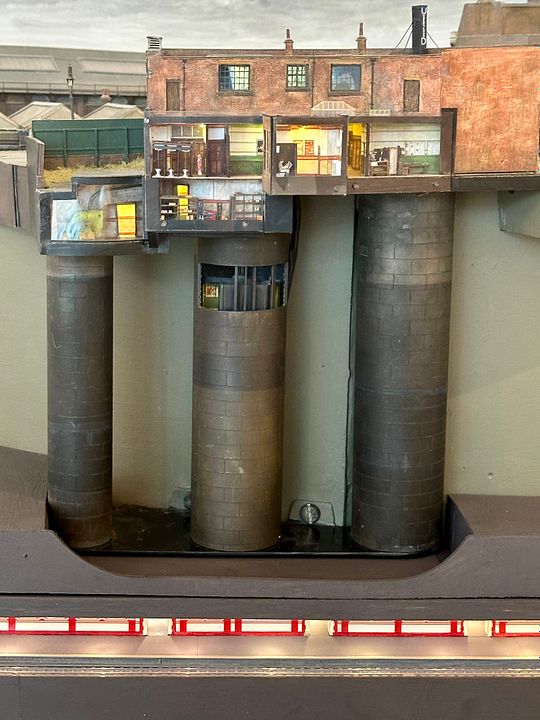 Tim |
|



